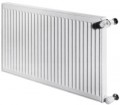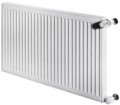Manufacturer's warranty
The manufacturer's warranty period for this model.
Usually, the terms of the warranty provide free rectification, replacement and/or compensation if the radiator fails during the stated period due to manufacturing defects. The greater the guarantee, the higher the quality of the product and the higher its cost (the latter, however, is usually compensated by high reliability). In modern radiators, the warranty period can be up to 10 years.
Note that the end of the warranty does not mean the product will immediately fail: with proper workmanship, the total service life exceeds the warranty significantly.
Panel type
The type to which the panel radiator belongs (see Radiator type).
The type is indicated by a number that describes the number of heating panels and convectors in this model. Panels occupy the entire height and width of the radiator, and convectors are special zigzag structures between panels that improve heat output. As for the designation itself, the first digit in it corresponds to the number of panels and the second to the number of convectors. For example, the popular type
22 provides 2 panels and 2 convectors between them (the convectors are located inside the radiator, each is attached to its panel), and in the less popular type
21, there is only one convector, respectively, common to both panels. There are options without convectors at all — for example, the simplest type
10, with just one panel. And one of the most advanced today is type
33, more convectors/panels are extremely rare.
In general, more elements (with the same device size in width and height) improves the overall efficiency of the radiator but it comes at the expense of price, depth, and weight.
Operating pressure
Radiator operating pressure.
This term usually means the highest pressure of the heating medium that the radiator can sustain without consequences for an indefinitely long time. Higher rates are also allowed for a short time (see "Maximum pressure"). However, the standard operating pressure in the heating system should not exceed the specs of the radiator; otherwise, the product is likely to be damaged. In general, it is believed that this indicator should be at least 2 bar higher than the actual working pressure in the system — this will give an additional margin of safety in case of emergencies.
Max. pressure
The highest heating medium pressure that the radiator is capable to sustain without consequences during short-term exposure.
This figure is always greater than the operating pressure (see above). It directly shows the resistance of the product to emergencies, primarily the water hammer. Other things being equal, higher maximum pressure means greater strength and reliability — however, such radiators are more expensive.
Heat transfer medium volume
The volume of water or other heating medium required to fill the radiator.
This information is relevant mainly when building an autonomous heating system: it is useful when calculating the total volume of heating medium in the system and related parameters. If the radiator is purchased for use in centralized heating, you can not pay much attention to its internal volume.
Heat tranfer medium max. temperature
The maximum heating medium temperature allowed for a radiator is the highest temperature the product can withstand without consequences for a sufficiently long time.
The maximum temperature for heating systems (both centralized and autonomous) is +95 °С as standard. Thus, most radiators have an upper temperature limit of +110 ... 120 °C — this allows you to withstand such conditions confidently.
Heat output
The rated thermal output of the radiator is the amount of heat given off to the air in normal operation.
When choosing this parameter note that the heat output will depend on the temperature difference at the inlet and outlet to the radiator, as well as on the ambient temperature. The greater the temperature difference and the colder it is around, the more intense the heating will be. Therefore, in the specs, it is customary to indicate heat transfer for certain standard conditions. In particular, the designation according to the European standard EN-442 is very popular, which assumes heating medium temperatures of +75 °С and +65 °С at the inlet and outlet, respectively, as well as an air temperature of +20 °С. Real conditions and the actual heat output of the radiator may differ; therefore, when choosing, it is best to choose a model with a certain margin and compensate for excess power with one or another regulator. As for the actual values, in the most modest models, the heat output
does not exceed 750 W, or even
500 W, and in the largest, this figure can reach
3.5 – 4 kW or
more.
The choice for this parameter depends primarily on the size and specs of the heated space. The simplest calculation formula is as follows: at least 100 W of thermal power is required per 1 m2 of area. This formula is relevant for standard r
...esidential/office premises with ceilings of 2.5 – 3 m, without problems with thermal insulation; for more specific conditions, there are more detailed calculation methods, that can be found in special sources.Radiator depth
The size of the radiator from the front to the back wall.
This parameter determines both the size of the space occupied by the device and its efficiency: other things being equal, a greater depth means a higher heat output (due to an increase in the area of contact with air). Specific nuances depend on the type of radiator and the method of its installation (see above). So, the most critical depth is for convectors with a horizontal layout, mounted in a niche — in them, this size directly determines both the required dimensions of the niche and the area of the working surface. In column models, this dependence is somewhat less pronounced. In panel devices, the efficiency depends not so much on the depth as such, but on the number of working elements (see "Type (panel)") — although a larger number of panels/convectors inevitably affects the dimensions. And sectional radiators most often have a relatively small depth: the differences between them in this parameter are not fundamental.

